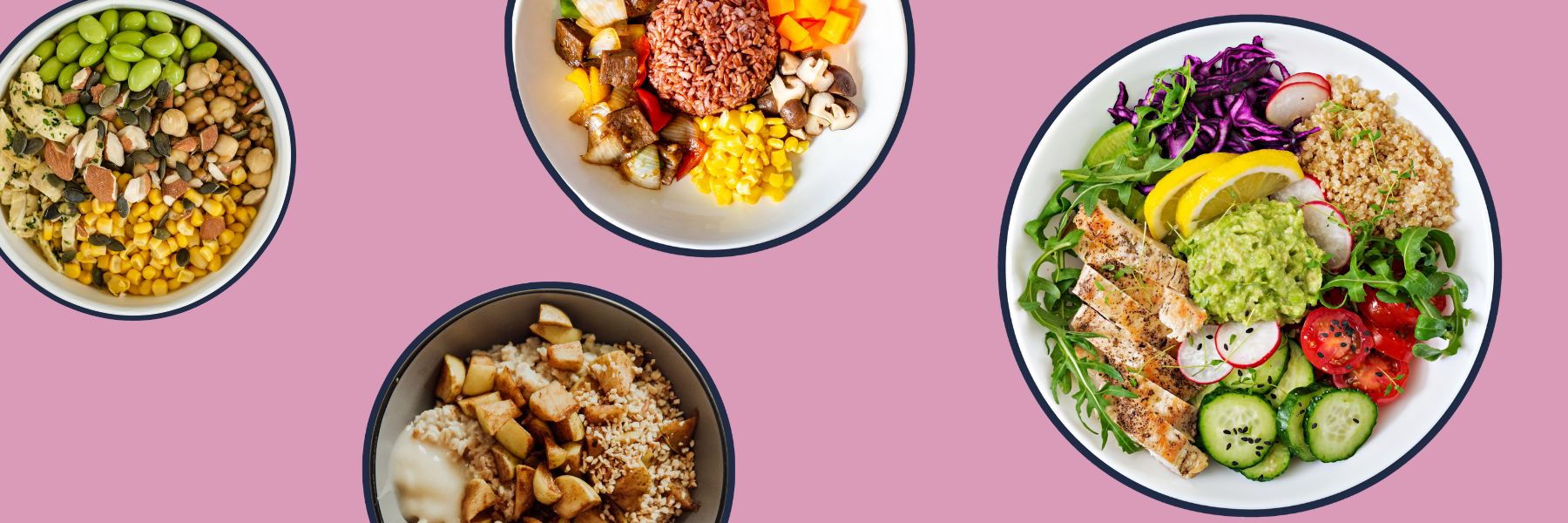

· By Olivia Silverthorne
The Art of the Balanced Plate: Eating Well Without Overthinking It
Eating healthy, balanced meals doesn’t have to feel complicated or overwhelming. In fact, once you understand the basics, creating a balanced plate can become a simple, even enjoyable, part of your routine.
Balanced meals are the foundation of long-term health. They keep you full, satisfied, and nourished, without relying on fad diets or passing health trends.
In this blog post, we’ll go over the building blocks of a balanced plate and walk you through a straightforward, step-by-step guide you can apply to any meal. Once you know the formula, you’ll have a reliable framework to make sure every plate you put together fuels your body the right way.
Half of your plate: Fruits and veggies for fibre
We all know fruits and vegetables are an essential part of a healthy diet, yet many of us still fall short of the recommended amount each day. Making them a core part of your plate is one of the simplest ways to improve your nutrition.
One of the biggest reasons fruits and veggies matter is fibre. Different types of fibre play unique roles in the body, from keeping digestion regular, to helping control blood sugar, to feeding the “good bacteria” in your gut that support overall health.
The key isn’t just eating enough fibre, but eating a diverse range of it. That’s why aiming for variety in your fruit and vegetable choices throughout the week is so important.
Beyond fibre, fruits and vegetables are also rich in essential vitamins, minerals, and antioxidants, all of which help your body function at its best. By including a wide range of produce, you naturally cover more of these important nutrients without needing to overthink it.
A simple rule of thumb? Eat the rainbow. The more colour you can add to your plate, the broader the spectrum of nutrients you’ll take in. Think of vibrant carrots, leafy green broccoli, deep red beetroots, and bright berries.
Try to aim for around half of your plate to be made up of a range of fruits and veggies, here are some examples of the different types:
- Leafy greens- spinach, rocket and kale
- Root vegetables- carrots, beetroot, parsnips and turnips
- Legumes and peas- edamame, sugar snap peas and garden peas
- Cruciferous vegetables- broccoli, cauliflower and brussel sprouts
- Other fruits- kiwis, apples, bananas, grapes, peaches
- Berries- blue berries, raspberries, strawberries and black berries
One quarter of your plate: Complex carbohydrates
Complex carbohydrates are a key building block of a well-balanced plate. Carbohydrates in general are the body’s preferred source of energy, they’re what fuel your brain, muscles, and daily activities.
But not all carbs are created equal. Complex carbohydrates are especially valuable because they take longer for the body to break down, providing a steady release of energy rather than a quick spike and crash. This slow digestion also helps keep you fuller for longer, which can reduce unnecessary snacking and support better appetite control.
Another major benefit is fibre. Complex carbs naturally contain more fibre than simple carbs, and fibre is a nutrient most people don’t get enough of. Including fibre-rich foods in your diet is essential for many reasons: it helps regulate blood sugar levels, supports gut health by feeding beneficial bacteria, and contributes to healthy digestion.
You want to aim for around a quarter of your plate to be made up of complex carbs.
Here are some examples you can add to your plate:
- Oats
- Brown rice
- Sweet potato
- Beans
- Quinoa
- Buckwheat
- Whole grain pasta
Another quarter of your plate: Protein
Protein is one of the most talked-about nutrients and for good reason. It plays a crucial role in the body, from keeping you full and satisfied to supporting muscle repair and maintaining stable blood sugar levels. Protein is also essential for healthy hair, skin, and nails, and contributes to the production of enzymes and hormones that keep your body functioning optimally.
When choosing protein, lean sources are often the best choice, as they provide the benefits of protein without excess saturated fat, which can be harder on the heart when consumed in large amounts. Examples of lean protein include chicken, turkey, fish, eggs, tofu, legumes, lentils, and lean cuts of beef or pork.
Aim for protein to cover roughly one-quarter of your plate at each meal. This ensures you’re getting enough to stay full, support muscles, and maintain energy, whilst still making enough room for those other important components of your plate.
Here are some examples of what you can use:
Animal-based lean proteins:
- Chicken breast
- Turkey breast
- Lean cuts of beef (e.g., sirloin, tenderloin)
- Lean cuts of pork (e.g., pork loin, tenderloin)
- Fish (cod, haddock, seabass, salmon )
- Eggs and egg whites
- Dairy (Greek yogurt, cottage cheese, halloumi)
Plant-based lean proteins:
- Tofu
- Tempeh
- Lentils
- Chickpeas
- Black beans, kidney beans, or other legumes
- Edamame
- Peas
- Seitan
1-2 table spoons on your plate: Healthy fats
The importance of healthy fats is often overlooked when building a balanced plate. Yet, they’re absolutely vital for the body, playing key roles in hormone production, supporting brain health, protecting cells, and helping us absorb fat-soluble vitamins like A, D, E, and K. Far from being something to avoid, healthy fats are an essential part of overall wellbeing and should be included in every meal in some way.
That said, it’s important to understand the difference between healthy fats and saturated fats. Healthy fats, such as those found in avocado, nuts, seeds, olive oil, and fatty fish, can help protect your heart and reduce inflammation. On the other hand, diets high in saturated fats (commonly found in processed foods, butter, fatty cuts of meat, and fried foods) can raise cholesterol levels and increase the risk of heart disease when eaten in excess.
Because fats are the most calorie-dense macronutrient, portion size matters. A good guideline is to aim for healthy fats to make up about 1/8 of your plate, or roughly 1–2 tablespoons per meal. This might look like a drizzle of olive oil on a salad, a small handful of nuts, a few slices of avocado, or a portion of salmon. This amount is enough to reap the health benefits of fats whilst making room for protein, complex carbs, and vegetables.
Some examples of healthy fats are:
Plant-based healthy fats
- Avocado
- Olives
- Olive oil
- Nuts (almonds, walnuts, cashews, pistachios, pecans)
- Seeds (chia seeds, flaxseeds, pumpkin seeds, sunflower seeds, sesame seeds)
- Nut butters (peanut butter, almond butter, cashew butter)
- Coconut (in moderation, as it’s higher in saturated fat)
Animal-based healthy fats
- Fatty fish (salmon, mackerel, sardines, herring, trout, tuna)
- Eggs (especially the yolk)
- Full-fat dairy (e.g., Greek yogurt, kefir, cheese)
Putting it all together
By following the simple guideline of ½ vegetables and fruit, ¼ protein, ¼ complex carbohydrates, plus 1–2 tablespoons of healthy fats, you can create endless meal combinations that are satisfying, balanced, and nourishing.
Here are a few examples of how this formula comes together on your plate:
Breakfast
- Veggie omelette (eggs for protein + healthy fat) with whole grain toast (carbs) and a side of sliced avocado & tomato (fibre + micronutrients + fat).
- Overnight oats (oats for carbs) made with milk or Greek yogurt (protein), topped with mixed berries(fibre/micronutrients) and chia seeds (healthy fat + fibre).
Lunch
- Grilled chicken wrap (whole grain tortilla for carbs) with hummus (protein/fat), mixed salad veggies(fibre/micronutrients), and a drizzle of olive oil.
- Lentil and quinoa bowl (carbs + plant protein) topped with roasted vegetables (fibre/micronutrients) and a sprinkle of pumpkin seeds (healthy fat).
Dinner
- Baked cod (lean protein) with a side of brown rice (carbs), steamed green beans & carrots (fibre/micronutrients), and a small portion of olive oil or butter for flavour (fat).
- Chickpea & sweet potato curry (carbs + plant protein) served with spinach and peppers (fibre/micronutrients) and finished with a spoonful of coconut milk (fat).
Final thoughts
The best part about this formula is that it’s completely customisable. While we’ve shared plenty of examples in this post to get you started, the possibilities are endless and that flexibility is what makes it so effective.
Unlike fad diets or restrictive health trends, this approach to building your plate is sustainable and adaptable to your lifestyle. It’s simple, requires no weighing scales or calorie counting, and takes the stress out of eating well.
Once you’ve mastered this formula, you’ll have a straightforward tool you can rely on for a lifetime of balanced, nourishing meals.
